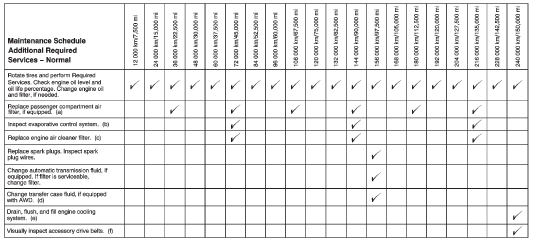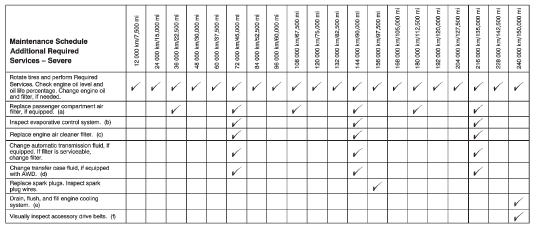Maintenance Schedule
Owner Checks and Services
At Each Fuel Stop
- Check the engine oil level.
See Engine Oil.
Once a Month
- Check the tire inflation pressures. See Tire Pressure.
- Inspect the tires for wear.
See Tire Inspection.
- Check the windshield washer fluid level. See Washer Fluid.
Engine Oil Change
When the CHANGE ENGINE OIL SOON message displays, have the engine oil and filter changed within the next 1 000 km/600 mi.
If driven under the best conditions, the engine oil life system might not indicate the need for vehicle service for more than a year. The engine oil and filter must be changed at least once a year and the oil life system must be reset. Your trained dealer technician can perform this work.
If the engine oil life system is reset accidentally, service the vehicle within 5 000 km/3,000 mi since the last service. Reset the oil life system when the oil is changed.
See Engine Oil Life System.
Tire Rotation and Required Services Every 12 000 km/7,500 mi
Rotate the tires, if recommended for the vehicle, and perform the following services. See Tire Rotation.
- Check engine oil level and oil life percentage. If needed, change engine oil and filter, and reset oil life system. See Engine Oil and Engine Oil Life System.
- Check engine coolant level.
See Engine Coolant.
- Check windshield washer fluid level. See Washer Fluid.
- Visually inspect windshield wiper blades for wear, cracking, or contamination. See Exterior Care. Replace worn or damaged wiper blades.
See Wiper Blade Replacement .
- Check tire inflation pressures.
See Tire Pressure.
- Inspect tire wear. See Tire Inspection.
- Visually check for fluid leaks.
- Inspect engine air cleaner filter.
See Engine Air Cleaner/Filter.
- Inspect brake system.
- Visually inspect steering, suspension, and chassis components for damaged, loose, or missing parts or signs of wear. See Exterior Care.
- Check restraint system components. See Safety System Check.
- Visually inspect fuel system for damage or leaks.
- Visually inspect exhaust system and nearby heat shields for loose or damaged parts.
- Lubricate body components.
See Exterior Care.
- Check starter switch. See Starter Switch Check.
- Check automatic transmission shift lock control function.
See Automatic Transmission Shift Lock Control Function Check.
- Check parking brake and automatic transmission park mechanism. See Park Brake and P (Park) Mechanism Check.
- Check accelerator pedal for damage, high effort, or binding.
Replace if needed.
- Visually inspect gas strut for signs of wear, cracks, or other damage. Check the hold open ability of the strut. See your dealer if service is required.
- Check tire sealant expiration date, if equipped. See Tire Sealant and Compressor Kit.
- Inspect sunroof track and seal, if equipped. See Sunroof.

Footnotes Ч Maintenance Schedule Additional Required Services Ч Normal
a) Or every two years, whichever comes first. More frequent replacement may be needed if the vehicle is driven in areas with heavy traffic, areas with poor air quality, or areas with high dust levels. Replacement may also be needed if there is a reduction in air flow, excessive window fogging, or odors.
b) Check all fuel and vapor lines and hoses for proper hookЧup, routing, and condition. Check that the purge valve, if the vehicle has one, works properly. Replace as needed.
c) Or every four years, whichever comes first.
d) Do not directly power wash the transfer case output seals.
High pressure water can overcome the seals and contaminate the transfer case fluid. Contaminated fluid will decrease the life of the transfer case and should be replaced.
e) Or every five years, whichever comes first. See Cooling System.
f) Or every 10 years, whichever comes first. Inspect for fraying, excessive cracking, or damage; replace, if needed.

Footnotes Ч Maintenance Schedule Additional Required Services Ч Severe
a) Or every two years, whichever comes first.
b) Check all fuel and vapor lines and hoses for proper hookЧup, routing, and condition. Check that the purge valve, if the vehicle has one, works properly. Replace as needed.
c) Or every four years, whichever comes first.
d) Do not directly power wash the transfer case output seals.
High pressure water can overcome the seals and contaminate the transfer case fluid. Contaminated fluid will decrease the life of the transfer case and should be replaced.
e) Or every five years, whichever comes first. See Cooling System.
f) Or every 10 years, whichever comes first. Inspect for fraying, excessive cracking, or damage; replace, if needed.
See also:
Front Fog Lamps
The front fog lamp button is located on the exterior lamp control, on the
outboard side of the steering wheel.
The ignition must be on to turn on the fog lamps.
(Front Fog Lamps): Press to ...
Battery Replacement
Notice: When replacing the battery, do not touch any of the circuitry on
the transmitter.
Static from your body could damage the transmitter.
Replace the battery if the REPLACE BATTERY IN REMOT ...
Brake System Warning Light
The vehicle brake system consists
of two hydraulic circuits. If one
circuit is not working, the remaining
circuit can still work to stop the
vehicle. For normal braking
performance, both cir ...






